The Corne¬ Daily Sunion
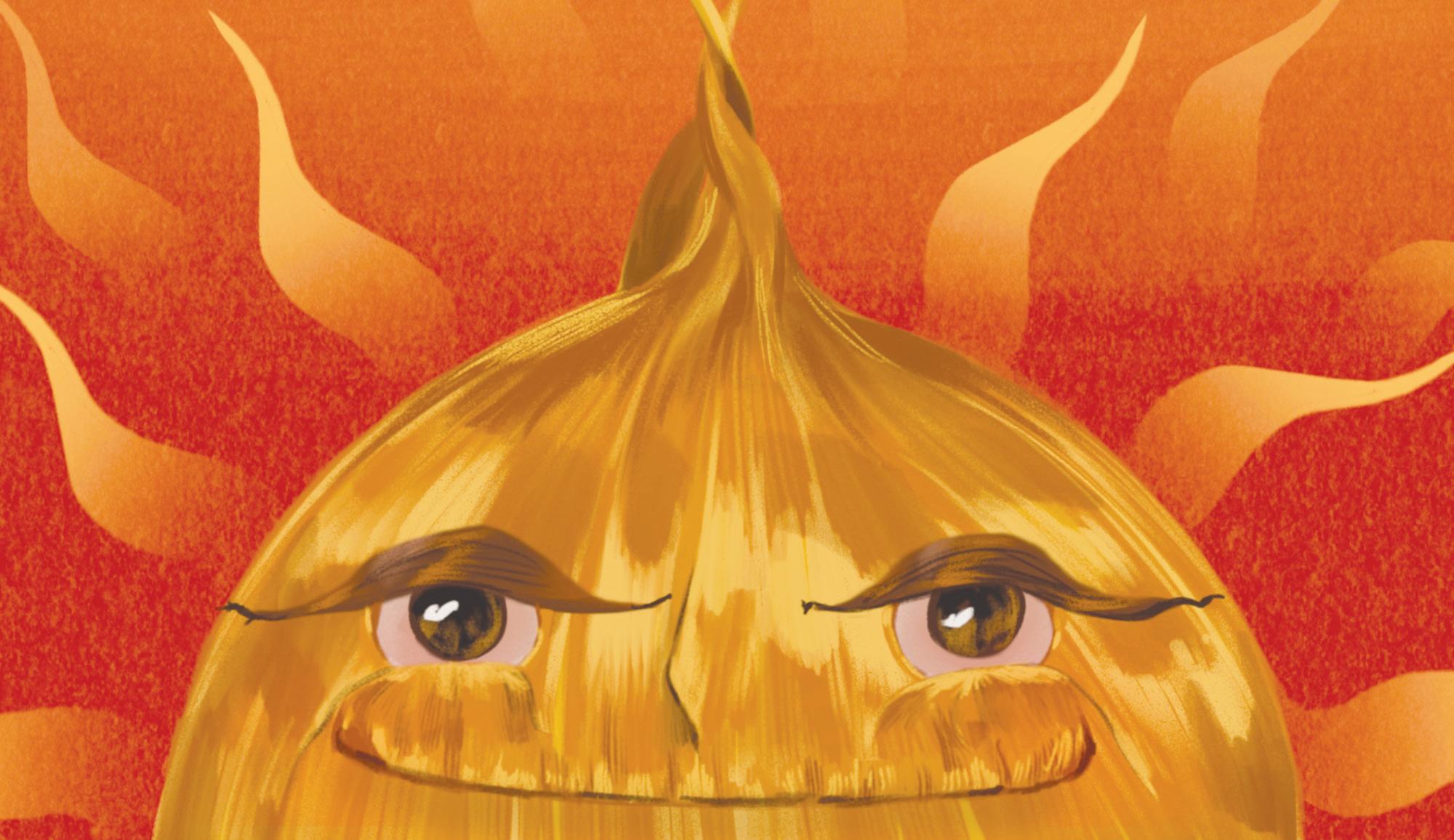


 By TRIGA WARNER Sun Staff Writer
By TRIGA WARNER Sun Staff Writer
Students are outraged following an incident in Government 6969: The Politics of Politics that occurred in class on Monday. Prof. Frida O. Skeech, government, cited research about political development in political environments from Columbia University without any warning, triggering students.
“I can’t believe I was subjected to research from the second-best university in New York,” Michael Silverman ’26 said. “I thought I was supposed to be getting a high-class education from an elite Ivy League institution.”
Cornell students have recently been posting to Sidechat about the increase in teachers spouting research from Columbia University.
“Anyone else have a prof mention Columbia with no warning?” an anonymous user wrote in a post with 369 upvotes. “What is happening to this institution?”



































While professors have historically had an understanding that all Ivy League research outside Cornell University is off-limits in classrooms, Cornell’s recent rise over Columbia in the U.S. News and World Report rankings have left professors confused.
“I don’t understand why students are getting so triggered about this,” Skeech said. “Rodents, Stanford, war — those I all understand getting upset over. But Columbia University? We surpassed them in the rankings — there’s nothing to be insecure about anymore.”
The controversy over the validity of the U.S. News and World Report has left some students feeling upset that Cornell may still
be the lowest-ranked university in the Ivy League. They say it is triggering when professors bring up Columbia and request that professors provide a trigger warning when discussing the school. more prestigious than Cornell,” Kelly Mark ’24 said. “I wish professors would be more mindful when select ing their research sources, and provide a warning should they need to present the material.”
Student Assembly convened to pass a resolution mandating trigger warn ings for any mentions of Columbia University in the classroom.
Columbia University can make stu dents feel inferior and be a big blow to their confidence,” the resolution read. “Requiring trigger warnings can ensure stu dents have time to exit the classroom should their ego be fragile.”
the attention of the national conservative media, who appear triggered over the trigger warning resolution.
“The liberal snowflake students at Cornell University need to get a grip,” the New York Post wrote. “They need to learn to embrace their last-place Ivy ranking. Besides, they are still part
Under national backlash, President Martha Pollack released a statement condemning the resolution and acknowledging Columbia’s superiority to Cornell, notably without any reader
“I understand that students are triggered,” Martha wrote in her media-relations crafted statement. “I acknowledge that it can be triggering to talk about Columbia. But if we can’t talk about Columbia without the presence of a trigger warning, how can we have a democracy?”
The controversy has sparked the creation of the 2023-2024 academic year theme, “Triggered-No-More: Freedom of Expression at Cornell.” Somehow, this theme will make students less sensitive and ensure steady
“Engaging with controversial topics is essential,” Martha wrote in yet another media-relations crafted email to the student body. “Suppress your triggered emotions, and let’s try to
Slope Day, a long-standing tradition, returns on April 20 featuring headliners Ryan Lombardi and Sigma Ligma Balls Fraternity DJ, Jake Chadson ’25.
When he is not serving the campus community as the vice president for student and campus life, Lombardi attracts a vast fan base on SoundCloud with his recently leaked account “Lil Lombard,” including several Cornellian fans.
“My favorite track is ‘Martha’s Weather Machine Mash’ because of how it encapsulates this one week in February when I walked to class from North [Campus] in negative
5-degree weather one day and 70-degree weather the next,” said Marsha Pommack ’26.
When asked about Lombardi’s inclusion on the lineup, Jay P. Morgan ’24 connected the dean’s journey into the music industry to his own experience as an Industrial and Labor Relations student.
“I didn’t know [Lombardi] was a musician,” Morgan said. “But as someone originally interested in unionization and ethical labor, yet later found their passion for investment banking, I really think it is cool when people try new things and ultimately pursue careers that spread joy in the world.”
After the long-anticipated lineup was released, students
flocked to Sidechat to discuss the artists.
“Am I the only one who has zero clue who the people for Slope Day are…?” said an anonymous Sidechat user.
This comment was met with extreme backlash, with some students expressing that the original poster should be more knowledgeable about Chadson in particular.
“Were you not at Sig Lig’s Groundhog Day darty, OP?” said an anonymous user. “Buddy was obliterating aux.”
The Slope Day Programming Board was given just enough of a budget to afford Chadson, who just so happens to be “tight” with the board members.
“Jake and I go way back,”
said SDPB president Coco Coin ’23, who has been a Sigma Ligma Balls sweetheart since 2012.
Budgets seem to be allocated sparingly in all organizations. The SDPB only had $250,000 to book both Lombardi and Chadson, who typically charge more for performances but gave the school a discount to make up for last year’s Slope Day, which was characterized as “lame” by almost all attendees.
“Who even was Aminé?” Lombardi said. “As the leader of Student and Campus Life, last year was frankly embarrassing. That’s why I knew I needed to step up.”
Overall, this year’s artists feel
overwhelming support from the Cornell community, each looking forward to being on stage in the near future.
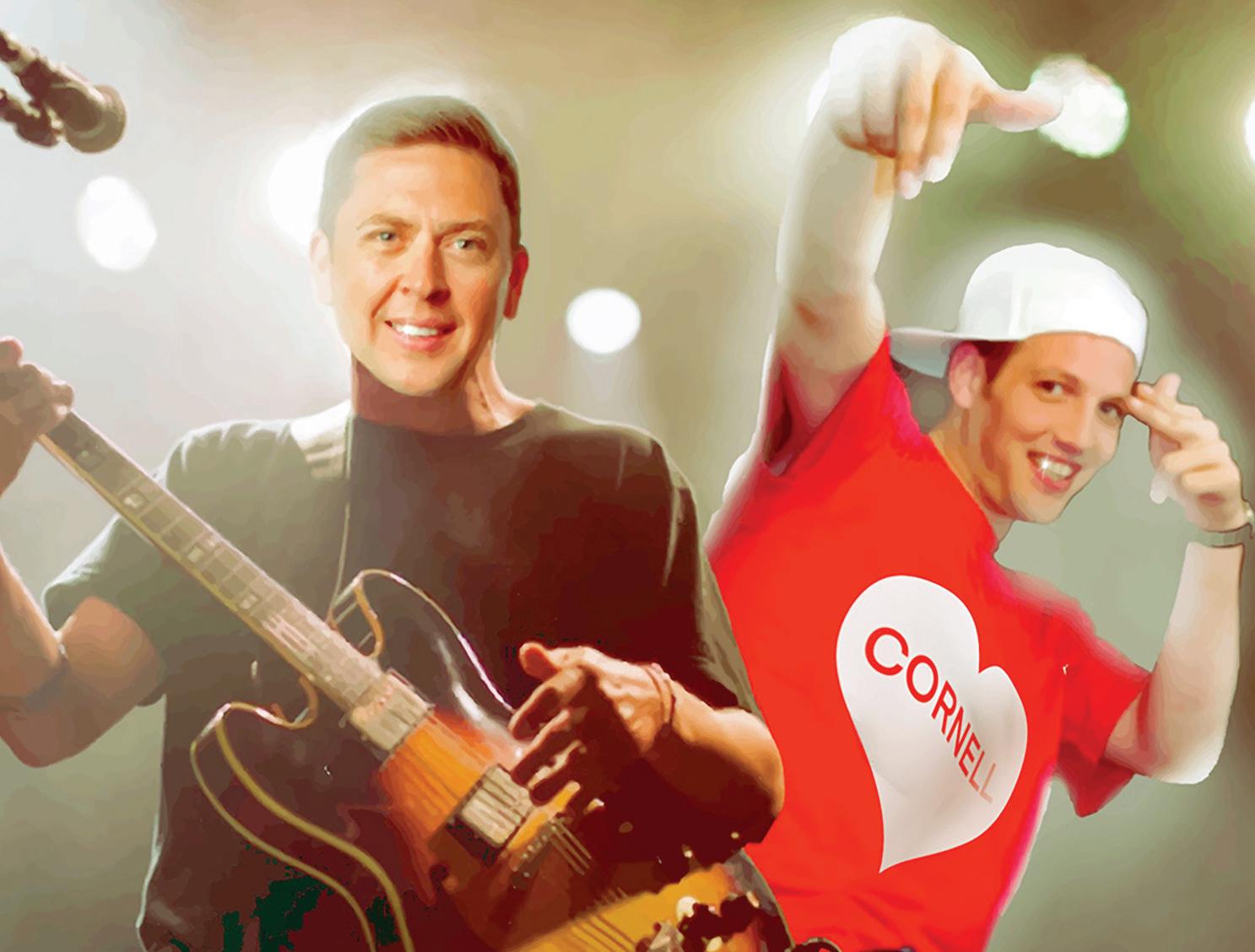
“Yeah, I’m stoked,” Chadson
said. “I’m ready to get lit on the Slope,” Lombardi added.
Ise Spicer can be reached at ispicer@cornellsun.com.
Who the 141st Editorial Board Would Include in Their Nightmare Blunt Rotation
ANGELA “NUTJOB-IN-CHIEF” BUNAY ’24
Te hosts of Love is Blind, Ronald Reagan, any ILR majors, anyone I have ever talked to on Tinder
KATIE “SUN MONOPOLY MAN”
CHEN ’25
Matt Damon
NOAH “‘S ARC” DO ’24
ChatGPT, Hans A. Bethe, Jungkook
HUGO “LIL OOZY WOOZY”
AMADOR ’24
Richard Nixon, Hunter S Tompson, Susan B Anthony
EMILY “FLORIDA MAN” VO ’25
Tom Wambsgans, Prof. Kyle Harms, the Cornell guy from White Lotus S1
JONATHAN MONGSTER”“COOKIE MONG ’25
Te Glee Club (y’all know where my loyalties lie)
JULIA “SENZ PICS” SENZON ’26
Te Sun alumni, my 8th grade math teacher
JIWOOK “JIWOOKIPNIDA” JUNG ’25
Te YMCA lifeguard, people with mullets, slow drivers
JULIA “EVERYTHING BAGEL”
NAGEL ’24
Te Sun Founders
GRAYSON “THE THIRD SPLASH BROTHER” RUHL ’24
Tom Brady, Bill Belichick, any fan of the New England Patriots
TENZIN “TEN OUT OF TEN”
KUNSANG ’25
Candace Owens
JOANNE “DR. WHO” HU ’24
My abusive friend in sophomore year, Elon Musk, those white alpha fnance bros in black Patagonia vests who never reply to my emails
MARISA “RIZZA” CEFOLA ’26
Stephen Lee, my dad, all my spit sisters to the same guy, Julia Senzon
MAX “THE JEW BEAR ™” FATTAL ’25
Queen Lizzie, Liz Truss, James Spader in Crash, James Spader in Sex, Lies, and Videotape, James Spader in Secretary
KYLE “BEEF CAKES” ROTH ’25
Hanging out with TikToker Jeremy Scheck ’22
MING “UNPAID SUN-TERN”
DEMERS ’25
Te other Sun editors
KATE “THE HATER” KIM ’24
Crypto bros, frat bros, any bros, really
ELI “ALIVE (?) ELI” PALLRAND ’24 the voices
ESTEE “RE(TIRED)” YI ’24
Machine Gun Kelly
To the Editor:
SOFIA “SO FYRE” RUBINSON ’24
Jimmy Jordan, Laura Lewis, Zachary Winn
ELISE “RESIDENT HACKER” SONG ’24
Te WordPress overlords
AIMEE “SLAYDHD” EICHER ’24
My ex (any of them), Trinity kids
GABRIELLA “DESPACITO” PACITTO ’24
Andy Bernard, Debbie Ryan, Izzie Stevens
ERIC “EASY-E” REILLY ’25 Kyrie Irving, Steven Koonin, the 21-22 Golden State Warriors
NIHAR “IT’S NOT HEDGE” HEGDE ’24 Lakers fans
JAMES “LICECOMB” CAWLEY ’25
Frat guys who drive Jeep Wranglers, Te guy in my dorm who doesnt fush his pubes, Scarsdale Highschool alumni
RUTH “THE NOTORIOUS RVA” ABRAHAM ’24
Te Founding Fathers, my 12th grade AP Bio teacher
MEHER “I’M GONNA KMS” BHATIA ’24
Your mom, Tobias Funke, Ms. Dabney
STELLA “BLABLABLA” WANG ’24 Blackpink, Cole Sprouse
MARIAN “HORSE” CABALLO ’26
Kanye West and anyone from Bronx Science (guilty)
GABRIEL “PRINCESS POPPER” MUNOZ ’26
Te guy I hooked up with and then blocked me during O week (He lives in my dorm)
KIKI “KOOKY PLOWE” PLOWE ’25 My parents, Jeremy Entner
CLAIRE “CAMERA QUEEN” LI ’24
People who use iPhone cameras
DAVID “YOUR HIGHNESS” SUGARMANN ’24 Skyler White and Walter Jr.
KASSANDRA “PUFF-PUFF-KASS” ROBLEDO ’25
Michael B. Jordan (saving me from the nightmare), my dad, Hailey Bieber, any fnance bro
VEE “GRANDMACORE” CIPPERMAN ’23
Reputation era Taylor Swift, egotistical Dyson sophomore in my English class, any Green Dragon barista
JASON “DEADBEAT EDITOR” WU ’24
James Corden, Jimmy Kimmel, John Oliver
Against popular opinion, I must say I am truly enjoying all of the content you are publishing. From topics on free speech to Greek life — you’re doing it all. And you’re doing it poignantly. That being said, I need you to relax this week. All these serious topics on local and national events is, how do I put this, killing my vibe. Today is perhaps the most important national holiday after St. Patrick’s Day. I know how important your job is, but could you possibly consider taking the day off today? Maybe meet me on the slope for a quick smoke and I can pitch you my idea on why twinkies are the best drug day snack.
I see how you make your way to The Cornell Daily Sun Office every week. Textbooks in hand after a long day of classes only to spend another few hours reading the countless emails and guest submissions from angry readers. For my sake, and yours as well, how about you call in sick today and celebrate this holy day with us?
What will it be: Indica or Sativa? I admire all you do, editor, really. But today I hope to see nothing but you enjoying the fresh air and warm weather as we ride this breeze towards spring.
Lukewarm regards, A devoted (and usually stoned) reader
To the Editor:
Every day I seem to crave the euphoric feeling that only marijuana can provide. I can feel the boundaries of myself dissipate, as I become one with the world — I don’t know where I begin or where I end…I inhale and exhale. I start to receive glances as people crane their necks to see who’s blazing up on the slope. Well, that stoner is me and this is my story.
At the start of freshman year, I came to Cornell intoxicated by my pre-med dreams. I imagined myself girl-bossing in my lab coat, making crazy concoctions that turned vibrant colors and making errorless calculations. The lab would end with a typed-up lab report fit for a Nobel. You can imagine the disillusionment that followed after my first month of CHEM 2070, Cornell’s most famous weed-out class. Given Cornell’s culture of overachievers is more toxic than potassium cyanide, people never talk about what happens if you are, dare I say…weeded out of this class.
It began with a string of mistakes. During a titration, the beaker slipped through my hands and I happened to “drop the base” but I wasn’t at a frat party so this ironic mistake did not win me lab partner friends. I found the Bohr model lab so Bohr-ing that I slept through the entire thing. The lab instructor orbited the lab tables like an excited electron yet refused to answer any of my questions. In a final plea for help, I told her that my understanding of chemistry concepts was very much like water and oil…I simply could not dissolve the material. One time I even ended up with a 420% error, I thought that was a bit too high.
About a month in, I was approached by a group of TAs who splashed vinegar on me as I walked through the door. I learned in my plant biology class that vinegar was a good way to naturally get rid of weeds. I realized that I was the weed, just chemically baptized by Prof. StepHen Lee’s cronies who led me down a set of stairs to a room they called The Joint (located somewhere in Baker Hall). This is where it got weird. Rows of potted plants lined the walls and the room, dank and musty, reeked of pot. I was approached by a group of redeyed, green lab coat-wearing students who called themselves StepHen’s Stoners.
They told me they were studying tetrahydrocannabinol (THC) and lit up a fat joint. They had their research question written on a chalkboard: How does inhaling a gaseous vapor release so much pressure from my life? I inhaled for the first time ever. I was always seen as a goody-too-shoes in high school but as they say all good things must come to an end. I was enraptured by the chemical reaction occurring in my brain. In one day I had gone from performing scientific experiments to experimenting with drugs — which involves more chemical reactions anyway… ones that you can feel!
The kids that are weeded out of CHEM 2070 provide ganja to the entirety of the Cornell student body. While their grades may be exceptionally low, they keep the student body extraordinarily high.
C. BeeDeeTo the Editor:
Frankly, I find it ridiculous that The Sun’s opinion section keeps refusing to publish my guest articles. I have, like, some good ideas. I’m thinking about stuff that no one’s willing to talk about. Like, what about “GUEST ROOM | Gay Son or Thot Daughter?” sounds so unpublishable? My boys and I get frosted and talk about stuff like that all the time. It’s stuff people actually want to read about. Like, it’s lowkey a hard question right? Or how about “GUEST ROOM | The Case for the Top G.” How are you just turning down this life-changing information? My guys and I should just start a podcast or something. Have fun in the matrix, Daily Sun. Future podcaster/street interviewer
If you find that you’re hitting the blunt far more often than you’re hitting the spot down there, keep reading. Dr. Love has some tips that are sure to get your unmentionables some Big Red love.
First of all, always ask about their body count. People in general find it really attractive when you’re invasively curious about their past sexual encoun-
ters.
Don’t forget to make a grotesquely obvious innuendo to really get them going. “What color is it?” is a classic, and “do it jiggle?” is another killer line. You can also ask if they’re a munch, but don’t be too disappointed if they aren’t down to get down.
Dr. Love is a certifed sex and romance specialist. Tey’re also a virgin.
a passion for serving the community, Urbas was awarded a $15,000 grant
 By MARIAN CABALLO
Editor
By MARIAN CABALLO
Editor
STEM mentor and future nuclear engineer
Natalia Urbas ’23 has been awarded the Cornell Class of 1964 John F. Kennedy Memorial Award for her academic and community contributions. Urbas was honored at the Einhorn Center for Community Engagement's awards lunch and reception on April 18.
“Natalia dazzles you, at first, with her [academic] numbers and the fact that she’s done so well in her classes and in Reserve Officers' Training Corps,” said Cynthia Wolloch ’64, chair of the JFK Memorial Award for Public Service. “But what really got us was her story.”
According to Wolloch, the Class of 1964 established the $15,000 JFK Award in their senior year in remembrance of late President John F.
Kennedy’s life and commitment to public service. Initially fueled by fundraising events and cap-andgown deposit givebacks, the award — available to graduating seniors pursuing service careers — has been granted to one or two students each year since 1965.
“[JFK’s death] was the calamity of our generation,” Wolloch said. “This class [of 1964] gift is about what can we do to honor the memory of this man who inspired us — who said, ‘Ask not what your country can do for you, but what you can do for your country.’”
JFK’s famous message has guided Urbas’ academic and extracurricular endeavors.
“From a very young age, it was clear to me that I had opportunities that other people didn’t,” Urbas said. “That puts me in a position where I have to do something for others.”
Students at Dewitt Middle School and Boynton Middle School have the opportunity to make modular origami, play a math version of Wordle and challenge themselves with mathematical Sudoku, also known as KenKen. At weekly math circle meetings, Cornell student mentors impart their love for mathematics to local middle-school students in a non-academic setting.
Ithaca Math Circle was founded by Maya Mau ’24, with its first semester of operations in the fall. Mau had volunteered with the Cambridge Math Circle since the pandemic and was inspired to implement a similar program for the Ithaca community. Her mother grew
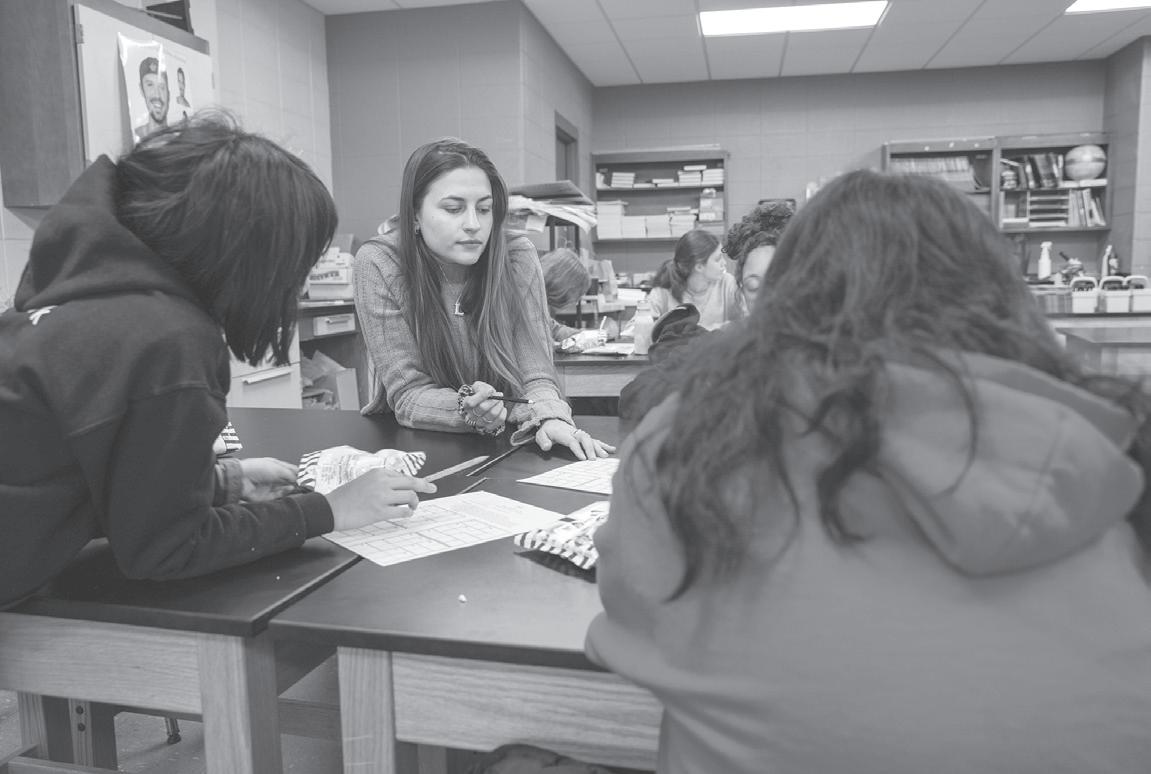

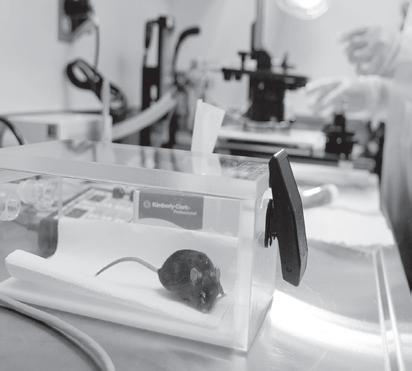 By CHRISTOPHER WALKER Sun Contributor
By CHRISTOPHER WALKER Sun Contributor
up in the Ithaca City School District and told Mau the impact the education system had on her, inspiring her to start a math circle in the local community.
Mau also said she was drawn to math circle because she thought she was bad at math until she had a great mathematics teacher in eighth grade that changed her experiences with the subject.
“By offering this for free in the public schools, my hope is that we can show kids who maybe thought they weren’t good at math or thought that they weren’t smart that they can pick up this stuff very quickly — and it can be fun too,” Mau said. “Hopefully this encourages them to enjoy learning through the rest of their lives."
See MATH page 4
From vacuums to vanities, the Ithaca Fixers Collective makes use of their skills and talent in repairing goods that would have otherwise ended up in landfills.
In 2012, Bruce Johnson, a founding member of the Fixers Collective, received an interest survey from a neighbor who was involved with the Finger Lakes ReUse Center to see who would be interested in a repair collective. The survey received public enthusiasm, giving birth to the Fixers Collective. Since then, the organization has logged over 2,000 unique visits in its record-keeping binder.
The collective meets every Saturday afternoon in the Ithaca ReUse Megacenter to repair damaged items.
“You get to meet people that… hate to throw things in the landfill,” Johnson said. “So we share that.”
Members of the collective fix anything that can become broken — including furniture, appliances, clothing and countless other belongings. To test repaired electronics, power strips hang from the ceilings in the fixers’ meeting room.
Roger Christian, a local carpenter and veteran, attends the collective regularly and specializes in repairing furniture of any kind. Motivated by his hatred for landfills, Christian repairs broken furniture that would otherwise be discarded.
While living in Florida, Christian witnessed firsthand the impact of landfills on populations firsthand, such as the birth deformities prevalent among migrant laborers subject to landfill conditions.
“Where did the laborers stay?” Christian said. “They stayed in the shanties which were located over landfills.”
Aside from the uniting anti-landfill sentiment of the collective, its members said they have more reasons for being involved. The communal support of like-minded people plays a role in Johnson’s continued attendance.
The Fixers Collective has ambitions to spread its mission around the city. Last month, the Collective was invited by the Finger Lakes library system to a gathering of all 33 of its libraries. At the gathering, the collectives explained their cause to libraries that expressed interest in beginning repair cafes of their own. Offshoots of the Ithaca Fixers Collective are already in the works. The Community Quilting Center will launch on April 23 in the same room as the Fixers Collective.
“Our mission is that we want to open the door to quiltmaking for all, regardless of resources,” said Brigid Hubberman, one of the Center’s directors.
Similar to the Fixers Collective, the Community Quilting Center is also waste-avoidant. All of its fabrics are sourced via a donation from Peggy Dunlap ’59, according to Virginia Freedman, one of the Quilting Center’s leaders. Regardless of background, experience or occupation, the Fixers Collective invites all members of the Ithaca community to join them on Saturday afternoons.
“If you're even remotely interested in learning or saving something, you'll fit in,” Johnson said.

“Our mission is that we want to open the door to quiltmaking for all, regardless of resources.”
Brigid Hubberman
Thursday, April 20, 2023
U.S. Military Deployments and Public Opinion
With Carla Martinez Machain
11:25 a.m. - 12:40 p.m., G08 Uris Hall
What is Community Neuroscience?
With Marlen Gonzalez Noon - 1 p.m., 1219
Martha Van Rensselaer Hall
Energy Day Seminar
12:25 p.m. - 1:15 p.m., 165 Olin Hall
Can National Identity Trump Ethnic Favoritism?
With Risa Toha
12:30 p.m., Kahin Center
A Neuronal Population Hypothesis With Marlene Cohen
12:30 p.m. - 1:30 p.m., A106 Corson/Mudd Hall
Getting to Diversity: What Works and What Doesn’t With Frank Dobbin
3 p.m., G24 Fernow Hall
Careers in Science Presentation
3:30 p.m. - 5 p.m., Virtual Event
History of Archaeology at Cornell: 10-Year Anniversary Panel
4:30 p.m. - 6:30 p.m., 165 McGraw
Derivation of Complex Verb Morphology With James Crippen
4:30 p.m., 106 Morrill Hall
How Can History Help Us? The Example of Anti-Semitism With David Nirenberg
5 p.m. - 6:30 p.m., 228 Malott Hall
Stress and Anxiety in Pets
6 p.m. - 7 p.m., Virtual Event
Prototyping for Innovators With Elena Dieckmann
10:30 a.m., Virtual Event
Panel: Creating and Environmentally Safe and Socially Just World With Daphne Frias
11 a.m. - Noon, Bethe Common Room
Cherry Blossom PopUp Table With Cornell Botanic Gardens Noon, Arts Quad
Ingredients: A PopUp Shop With Thread Magazine
Noon - 4 p.m., Arts Quad
Microbes, Metabolites and Mucosal Immunity With Kathy McCoy
12:15 p.m. - 1:30 p.m., T1-003 College of Veterinary Medicine
Smart, Energy-Efficient and Grid-Interactive Buildings With Wang Shengwei
12:25 p.m., 253 Frank H. T. Rhodes Hall
A Model of D-Wave Superconductivity, Antiferromagnetism and Charge Order on the Square Lattice With Maine Christos
3:30 p.m. - 4:30 p.m., Virtual Event

Sculpture’s Artificial Intelligence: Theory and Technology With Megan Luke
5:15 p.m., Wing Lecture Room Johnson Museum

Independent Since 1880
Postal Information: The Cornell Daily Sun (USPS 132680 ISSN 1095-8169) is published by the Cornell Daily Sun, a New York corporation, 139 W. State St., Ithaca, N.Y. 14850. The Sun is published Tuesday and Thursday during the academic year, and every weekday online. Three special issues — one for seniors in May, one for reunion alumni in June and one for incoming freshmen in July — make for a total of 61 issues this academic year. Subscriptions are: $60.00 for fall term, $60.00 for spring term and $120.00 for both terms if paid in advance. Standard postage paid at Ithaca, New York. Postmaster: Send address changes to The Cornell Daily Sun, 139 W. State St., Ithaca, N.Y. 14850.
Andrew Morse ’96, this semester’s Zubrow Distinguished Visiting Journalist, visited campus Tuesday to discuss his work transitioning the Atlanta Journal-Constitution to be competitive in the digital era, the impacts of technology on journalism and the state of the journalism industry as a whole at an event titled “Inside Journalism.”
Cornell’s sprint football team held a ceremony on March 31 to celebrate the unveiling of their new locker rooms. After three years of planning, the team is set to use the locker rooms in the fall.
The idea behind the project began in March 2020 — right before the COVID-19 pandemic — which allowed months of brainstorming to come up with an economical solution.
Coaches Jay Carter and Willie Evans led a project team tasked with determining the best course of action to build the locker rooms. They determined the locker rooms should be built separately and then shipped to Cornell. After nearly two years of planning, the design was approved by Ithaca City Planning Board in 2022.

“The team now finally has a place to call theirs,” said associate head coach Bob Gneo.
The locker rooms are located behind the Crescent of Schoellkopf Field, providing sprint football with their own space to prepare for games, watch film and receive medical attention. Carter discussed how the building of this facility has benefited mul-
tiple aspects of Cornell athletics.
“By creating a new locker room for sprint football, it freed up our old locker room for women’s lacrosse,” Carter said. “In turn, this allowed for more space in Lynah Rink for both men’s and women’s ice hockey. It’s part of an overall athletic department plan to accommodate multiple teams. This was a tremendous win for every sport.”
In addition to the multiple-team benefit, the locker room has also allowed for further development of the sprint football team. Gneo explained how the lack of common space this past season affected the team’s performance.
“When we don’t have a standard size locker room, it’s difficult to have team bonding,” Gneo said. “No one shows up an hour early to spend time together. Before we moved, you would walk in the locker room at any point during the day and there would be a group of players watching TV, studying or just hanging out.
To continue reading this article, please visit www.cornellsun.com.
The event was sponsored by the College of Arts and Sciences’ Career Development office and moderated by Vee Cipperman ’23, who is a current senior editor and the former editor-in-chief of The Sun.
Prior to becoming president and publisher of the AJC, a 155-year-old newspaper, Morse served as a senior executive at CNN — where he was the architect of CNN+ — Bloomberg and ABC News. During his time at Cornell, Morse served as the editor-in-chief of The Sun.
Morse is known in industry circles as an advocate for digital media and for reinventing media outlets to fit into the modern media landscape. Following a brief introduction and explanation of his career path, Morse expanded upon his philosophy regarding digital transformation and the “digital-first” vision he holds for the AJC.
“We can build a really robust product, both with world class journalism and in great storytelling, [creating] connection points to people’s lives,” Morse said. “If we do invest digitally in the right kind of products with technology and marketing, we can build something that’s really meaningful.”
When asked about the effects of technological advancements on the journalism industry, Morse focused on the role of cell phones and how they have fundamentally changed not just the journalism industry, but society as well.
“It is almost impossible to describe just the impact that the smartphone has had on journalism,” Morse said. “The ability to have a device in your pocket that gives you access to anything, anywhere, all the time, is so powerful, much more than we even think. As we have seen [with] this rapidly advancing technology, every newsroom has to shift their mentality.”
Additionally, Morse discussed the way the AJC has changed how it breaks major stories to fit with the new paradigm.
“If we have a big story to break, we break it online,” Morse said. “The New York Times and their innovation report that they published in 2014 to spark their consideration — the biggest thing about that was the [print] paper came second. They focused first and foremost on the digital report. That’s what we’re doing at the AJC. We wake up and refocus 24 hours, and I think from a positive perspective it’s enabled us all to be better informed.”
Morse also said that artificial intelligence can be a useful tool for publications, which can use it to do basic work such as show traffic patterns or update sports scores.
“The short-term, immediate-use cases where I think AI can be most helpful in newsrooms is sorting through information for the public that it’s otherwise really hard,” Morse said. “You still need an editor to go through and verify, make sure it’s true and call around and get some quotes. But the legwork of the basic reporting — there’s value in [AI].”
He went on, however, to say that AI could be used to disseminate misinformation — particularly during electoral campaigns — and that it is journalists’ role to fight it.
“It’s much easier to use AI to publish a fake story filled with misinformation than it is to use AI as a fact-checking tool,” Morse said. “I don’t think it’s going to replace journalists. I don’t think it’s going to replace original reporting, mainly because I don’t think [AI-generated articles are] what customers want.”
Morse offered a piece of advice to aspiring journalists — gain as much experience as possible.
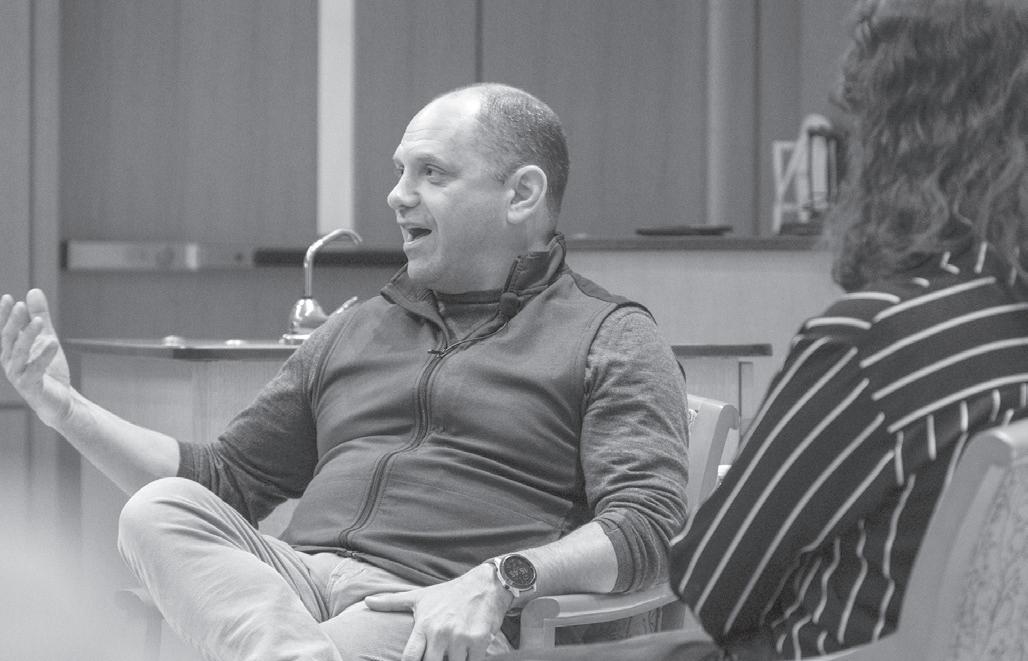
“There’s no better way to [learn] journalism than doing journalism. And so if you’re thinking it’s a career you want to pursue, do it. That’s step one,” Morse said. “Step two is, it’s really important to have a grounding in the business. … I think getting grounded in the broader forces and pressures on the industry — it’s really important to get grounded in that.”
To continue reading this article, please visit www. cornellsun.com.
STEM mentor and future nuclear engineer was awarded $15,000 for her dedication to others
has served as the diversity and inclusion chair for Cornell Materials Society and has participated in ROTC, academic research, the wrestling club and the Lodge, the co-op housing for low income BIPOC students where she has lived for three years.
Originally from Berkeley, California, Urbas said she wants to use the $15,000 to help create a materials science mentorship program aiding first generation students in Washington, D.C., where she will relocate for her new job with the Navy later this year.
“[When I applied], I was thinking if I got this award, and I got this money, I could do what I’m doing now — but better,” Urbas said, planning to focus her attention on mentoring women and people of color.
According to Action DC, a data analysis and policy leadership non-profit, Washington,
D.C. experiences substantial racial gaps in education outcomes.
“There’s a lot of potential in D.C. for a program like this to do a lot of good,” Urbas said.
She credits her aspirations to her mother, a first generation college student from Singapore who has supported Urbas throughout her academic journey.
“Having that resource makes a huge difference. I realize, though, not everyone has those support systems.” Urbas said. “Recognizing where I stand because of this support — and what a difference it can make for other people — is what made me want to work on [a mentorship program].”
Urbas is already mentoring others as a dedicated teaching assistant for courses within the materials science and engineering major, which consists of only around fifty students.
“I care a lot about the students I teach, arguably a little too much,” Urbas said. “I know all the undergraduates and I’m grading quizzes at the start of the semester trying to figure out who I should be worried about.”
According to Wolloch, Urbas stood out from a pool of extremely strong applicants.
“Sometimes [the selection board] has late night arguments, and we call back the next day and so forth, and keep going until we find the student that best exemplifies Cornell’s
spirit of contribution to the public good,” Wolloch said. “[Urbas] is that someone for young women.”
Preparing to graduate in May, Urbas expressed gratitude for her diverse experiences and relationships at Cornell. Recognizing how diversity strengthens an intellectual community, Urbas said she wants to nurture inclusivity and support through her mentorship projects.
“People from Cornell come from such different backgrounds,” Urbas said. “[I’ve realized] it’s not that you’re smart regardless of where you’re from. It’s where you’re from that has an impact on how you grew up and really shapes the way you think.”
To continue reading this article, please visit www.cornellsun.com.
“Recognizing where I stand because of this support ... is what made me want to work on a [mentorship program].”
Natalia Urbas ’23Sofa Cherchio can be reached at scherchio@cornellsun.com. Marisa Cefola can be reached at mcefola@cornellsun.com. Jonathan Mong can be reached at jmong@cornellsun.com. Erica Yirenkyi can be reached at eyirenkyi@cornellsun.com.
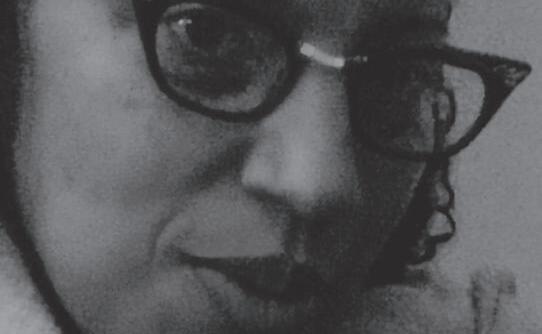
MATH Continued from page 1
Mau completed all the necessary paperwork to set up a nonprofit organization through the assistance of the pro bono clinic at the Cornell Law School. Though not affiliated with the University, the Ithaca Math Circle consists of Cornellian women mentors, purposefully chosen across majors to bring in their unique perspectives.
Ithaca Math Circle operated out of Dewitt Middle School last semester, but has expanded into Boynton Middle School this semester with the goal of serving more students. The group hopes to show students that learning math can be fun.
“As opposed to doing specific math skills, … we focus on problem solving and pattern recognition generally to build math skills and competence in ways that would be applicable to what they’re learning in the classroom,” said Ruth Steinhouse ’24, executive director of
Ithaca Math Circle.
The mentors are responsible for designing the curriculum for students. Games, puzzles and art projects are at the foundation of the club’s teaching style, facilitating student learning on topics ranging from Roman numerals and Morse code to geometry. Some weeks, students test their math skills to win prizes like dog themed stickers or skittles.

At a recent math circle meeting, middle school students expressed their fondness of the program to The Sun. Sixth grader Supantra Pann Hlaing described the meetings as much “funner” and more engaging than her traditional school math class.
To continue reading this story, please visit www.cornellsun.com.
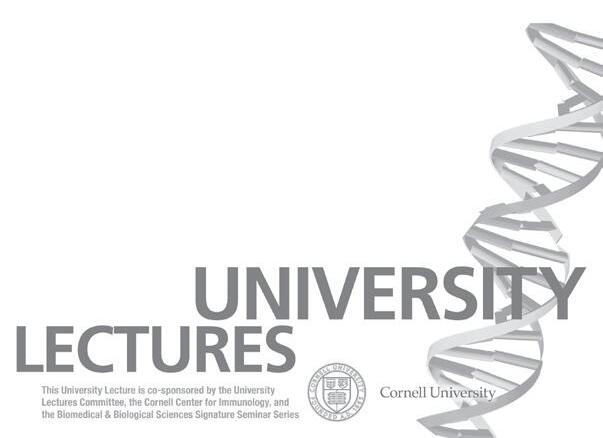




 By Aaron Zhu and Conner Smith Sun Dining Editor
By Aaron Zhu and Conner Smith Sun Dining Editor


Known for its wide variety of restaurants and food options, Ithaca’s Collegetown also sports a diverse selection of boba shops. With so much boba in such close proximity, it’s only natural that we’d want to compare them to find out which ones truly stand out. In this review, we will explore three popular boba shops in Ithaca, evaluating them based on their taste, texture, ambiance and overall experience.
KUNG-FU TEA (7/10)
Located in the heart of downtown Ithaca, Kung-Fu Tea offers a vibrant atmosphere that attracts both students and locals alike. With a diverse range of flavors to choose from, this shop provides an extensive selection of milk teas, fruit teas and even slushies. Their original boba milk tea was both chewy and had a rich flavor with just the right amount of sweetness — a perfect refreshment for the onset of summer warmth. The customer service is top-notch, with friendly staff that always seems happy to help. If you’re looking for a fun and lively place to enjoy your boba, Kung-Fu Tea is definitely worth a visit.
MANGO MANGO (10/10)
Mango Mango, located just up the hill from Kung-Fu Tea, is known mainly for its classic cake and dessert offerings. But don’t let that discourage you — Mango Mango also boasts a

surprisingly savory selection of smoothies, fruit teas and boba. Their original boba milk tea was not too sweet, yet not too bland — a perfect blend.
all, due to the texture of the pearls, balance of the milk tea and serenity of the environment, Mango Mango was both reviewers’ top choice.
U-TEA (5/10)
U-Tea, nestled off Dryden road in Collegetown, is a longtime favorite for Cornell students, known for its creative drinks and Instagram-worthy presentations.
Upon walking into the shop, you immediately catch the distinctive scent of U-Tea — the smell of tapioca pearls. U-Tea’s menu offers a variety of fruit and milk teas, all packaged in a modern aesthetic.
However, the boba was not quite as flavorful as its rivals Kung-Fu Tea and Mango Mango, and there were too many pearls to enjoy the milk tea without interruption. On a positive note, U-Tea offers a wide variety of authentic toppings such as lychee. While the ambiance is more minimalist, the friendly staff and innovative drinks make it a popular destination for many boba fans.
locations to find their personal favorite. Happy sipping!

Aaron Zhu is a freshman in the College of Arts and Sciences. He can be reached at az394@
cornell.edu. Conner Smith is a freshman in the College of Arts and Sciences. He can be reached at css289@cornell.edu.
Moreover, the boba pearls themselves were bigger than those of adjacent competitors, which both reviewers agreed worked to its advantage. The environment was clean and calming, and offered both the option to take-out or sit down (although the second option comes at a higher price). Over-
Ithaca’s boba scene has something for everyone. Whether you prefer a lively atmosphere, a tranquil environment or unique flavor combinations, there is a place for you.
While each of these three boba shops have their own distinct charm, Mango Mango takes the crown for its extensive menu, vibrant atmosphere and consistently delicious drinks. However, we encourage boba enthusiasts to visit all of these


Theiroriginal boba milk tea was both chewyand had a rich flavor with justtheright amount of sweetness — a perfect refreshment for the onset of summer
Acouple of weeks ago was Ivy Day; the day when most of us received a decision that changed the course of our lives forever. It has been exactly a year since I have received the fateful email from Cornell Admissions in my inbox. That day set me on a path where I first discovered that the world is bigger than my bubble in Southern California and life became more than getting into college.
It was the first time I genuinely felt lost because one of the biggest chapters of my life had finally closed. Even throughout all of the celebrations and congratulations, I was still left with the biggest question: What next?
Like most people, I measure my life by milestones. The way I see it, there are only four milestones to experience before I leave this world.
The first is high school graduation, which celebrates the last 12 years of your life and your efforts getting through elementary, middle and high school. This period of your life can arguably be the one where you go through the most changes.
From figuring out what to bring to show and tell all the way to studying for college admissions exams, it is a long period of time where your childhood slowly melts away to adulthood.
The next is college graduation. This period of your life is much shorter than the previous one, but it is one of the most emotionally challenging ones. You are figuring out your identity and suffering through most of your emotional turmoil alone.
The big questions start to infiltrate your life — What do I do with my degree? Where should I move to after I graduate? When will I see my family again? You are setting the foundation for the rest of your life and it is a big burden to carry for a 22 year old.
choose to undergo — having children. Thus, the cycle repeats again and you are left to live your life through your child’s milestones.
I understand that this is a very pessimistic way to view the world. I can hear the words of optimists around me arguing that you only live once, and that you are in control of your own life. Countless videos on my For You Page encourage me to go out there and live big.
These are all easy claims to make, yet no one seems to acknowledge that it’s hard to leave this cycle, especially when it’s ingrained into our current way of living.
This is the life course that many Americans take and will continue to take in the future. It seems too idealistic and naive to encourage people to change the narrative — change is difficult.
The next milestone is marriage. You’ve lived out your early 20s in a big city, found the love of your life and you realized this was finally the time, both financially and emotionally, to settle down and invest into your future.
This is when you start to get wary, because there is only one more milestone left, one that some don’t even
Perhaps I am the naive one to question the systematic nature of our lives. Perhaps I will soon embrace and welcome the mundanity and predictable course of my life. Perhaps it is even comforting to think that there are others who will experience the same experiences as me. Or, perhaps this is just the human experience — to embrace the common threads that link all of us together.
These are all big ideas to juggle, especially for a Monday evening. I even feel a little breathless with all of these thoughts coursing through my head. I’ll soon settle down in bed with a warm cup of tea next to me and finish off my book for the night.
I hear the sounds of chatter outside my dorm room where students are rushing off to find an open lounge to work on homework together. Outside my window, I see a girl running back to her dorm to quickly escape the cold. Trails of laughter follow behind her as her friends struggle to keep up with her.
These are all big thoughts that I don’t have to worry about for now. Instead, I embrace the present and snuggle into my bed, waiting for a new day to come again.
 Adin Choung is a freshman in the College of Human Ecology. She can be reached achoung@cornellsun. com. A Dinner is Served runs alternate Sundays this semester.
Adin Choung is a freshman in the College of Human Ecology. She can be reached achoung@cornellsun. com. A Dinner is Served runs alternate Sundays this semester.
These are all easy claims to make, yet no one seems to acknowledge that it's hard to leave this cycle, especially when it's ingrained into our current way of living.

Fill in the empty cells, one number in each, so that each column, row, and region contains the numbers 1-9 exactly once. Each number in the solution therefore occurs only once in each of the three “directions,” hence the “single numbers” implied by the puzzle’s name. (Rules from wikipedia.org/wiki/ Sudoku)





On March 16, Prof. James Lo, pharmacology cell and developmental biology, and his team published a study identifying different types of cells in the pancreas, an organ responsible for aiding digestion and regulating sugar levels.
The research team found one particular cell type to be closely linked to the development of type 2 diabetes.
These cells are classified as ‘beta cells’ — cells in the pancreas that produce insulin, a hormone that maintains normal sugar levels in the body.
When the body is unable to produce enough insulin or the cells in the body resist the effects of the insulin, the individual may develop type 2 diabetes over time.
To identify the number of beta cell subtypes present in the pancreas, the research group utilized a technique known as single cell RNA-seq.
According to Lo, RNA — the genetic material that helps cells synthesize proteins — is extracted from each individual cell in the pancreas to determine which genes were being expressed.
Lo and his team identified four different beta
cell types based on different genes expressed in each type.
One type of beta cell, named cluster 1 beta cells, showed better insulin production rates compared to other clusters.
However, the team discovered that cluster 1 beta cells had high expression of a gene responsible for producing CD63, a cell protein that acts as a marker for different types of beta cells.
“[CD63] happens to also be a cell surface
protein, so that makes it attractive, because we could use that as a tool or marker handle to selectively purify cluster 1 beta cells and separate them from the other beta cell groups,” Lo said.
After determining the different types of beta cells, Lo and his team analyzed the beta cells in two groups of mice: one fed a high-fat diet and one with type 2 diabetes.
Although all four beta cell types were found during the early to middle
stages of type 2 diabetes, their distribution differed from that of mice with normal diets.
Mice with type 2 diabetes showed low concentration in cluster 1 cells and CD63, resulting in decreased insulin production.
The findings indicate that these type of beta cells may be closely related to the development of type 2 diabetes.
Co-author Prof. Doron Betel, computational biomedicine, additionally
JESSICA RINALDI / THE NEW YORK TIMEScluster 1 beta cells.
More detailed experiments will be performed to understand how high CD63 cells resist effects of high glucose levels, according to Betel.
He added that the next steps include studying the organization of different beta cell types in the pancreas using spatial technology.
“The next wave of genomics studies is using spatial technologies to see the tissue architecture at a single cell level resolution”, Betel said. “And that might be informative to see whether these cells are organized in a very specific spatial form, or if they are just clusters of the cells that are distinct from each other.”
notes that cluster 1 beta cells with high CD63 levels may have the ability to reverse type 2 diabetes. When the research team transplanted these cells into mice with type 2 diabetes, they observed that the mice’s blood sugar were restored to normal levels.
In the near future, Lo plans to investigate the developmental pathway of these different beta cell types, hoping to potentially induce the cells to develop into a more high-functioning beta cell such as
The research has potential medical applications as a diagnostic marker and treatment option for type 2 diabetes patients, according to Lo.
“In terms of the future, if we can understand how we can make more higher-performing beta cells, there can be drugs, nutritional items or other regiments that may help us to obtain more highly functional beta cells for [type 2 diabetes] patients,” Lo said.
 By ANNA LABINER Sun Staff Writer
By ANNA LABINER Sun Staff Writer
On March 12, the Jugatae Outreach Committee, Cornell’s entomology club for graduate students, participated in Kid’s Science Day at the Big Red Barn and Expanding Your Horizon conference at Barton Hall,
where they shared their entomological knowledge with local kids.
As a student-run club, the JOC comprises many subdivisions, including a professional development committee, a social committee and an outreach committee, which represented the club at the annual Kid’s
Science Day. In addition to entomology, the event featured various other scientific topics and sectors ranging from ornithology to polymer chemistry, all led by graduate student organizations and clubs.
In addition to Kid’s Science Day, the outreach committee has been
involved in Cornell’s annual Insectapalooza, a oneday insect festival held in Stocking Hall, and more recently, the Expanding Your Horizons event, which took place on April 1 and focuses on introducing young girls to STEM topics.
Expanding Your Horizons is a one-day conference geared towards seventh to ninth-grade students aiming to “stimulate participants’ interest in math and science through handson activities, provid[ing] scientist role models and foster[ing] awareness of opportunities in math and science-related careers,” according to their website.
The conference was founded in 1988 by a group of graduate students and has since expanded greatly to accommodate the growing popularity of the program.
As participants in the conference, the JOC were able to share their entomological passions with enthusiastic young scientists.
“The kids come in and
we talk to them about characteristics that make an insect versus an arachnid, we take them to the collection, we show them drawers, we tell them about how insects are important and how diverse they can be and we talk about insect diagnostics since we have the insect diagnostic lab in the collection,” O’Hearn said.

The JOC additionally led an activity where students were assigned an insect and given a prompt about where it was found. For example, students were tasked with determining the type of insect found on a farmer’s plant. By classifying insects using specimens from the Cornell University Insect Collection as a reference, the committee hoped to educate young scientists about the importance of accurate identification and give them realworld scenarios of applying entomological knowledge.
With so many negative connotations surrounding insects, the JOC hopes to show young students that
these specimens are beneficial for our environment through their roles as secondary decomposers and managing pests, among other contributions.
The club aims to emphasize the relevancy of insect specimens from an agricultural, financial and ecological perspective, noting how pests can affect crops and the subsequent economic success of farms. From a broader perspective, the committee stresses that insect decline threatens many of the agricultural and food systems that we may take for granted.
“Children can grow to appreciate insects and not have as much of that fear that you see in a lot of adults today,” O’Hearn said. “In the community I come from, a lot of people have that negative perception of bugs, so it’s a way for me to give back.”


No matter if you’re an Engineer or an ILRie, a freshman or a junior, or whatever your career aspirations may be, Cornellians remain united by their ability to work hard now to get what is wanted now and into the future. However, one thing is certain for every student alike — everyone must eat.

As students turn on their devices and open their notebooks for the umpteenth time of the day to study, it is all too common to be too busy and occupied with schoolwork and other activities to grab something to eat and skip meals instead.
Maybe this is because sitting down to eat can take too long, itself be a distraction from studying, or simply be due to a smelly classmate or revolting lecture materi-
al putting you off your meal Luckily, Cornell Dining will be opening a new dining hall — Cornell’s first walkthrough dining hall.
An extension of Okenshields located in Willard Straight Hall, the purpose of this dining hall is to create a gourmet grab-and-go system of traditional dining hall foods so that students can quickly swipe their meal plan or purchase access to the dining hall. Freshly premade sandwiches, Chinese takeout boxes and pre-mixed salads and grain bowls on a rotating menu are kept warm or chilled for students to pick up while walking through. However, it is important to note that each swipe or entry into the dining hall is limited to one food item.
Built to never stop
the hustle and bustle of Cornell students, this dining hall is cleverly made of multiple food picking lanes and passing lanes to ensure no lines are formed. In fact, Cornell Dining is even considering implementing an airport-style moving carpet to help move Cornellians along to their destination even faster. There will be a drink chute located in the rafters of Willard Straight to distribute Bubbly water and guava juice into moving Cornellians’ cups, ensuring everyone stays hydrated during their busy days. There will also be a food-allergy friendly option located in the lawn outside of Risley Hall, as the prehistoric building cannot accommodate this groundbreaking technology.
VP Lombardi claims
that this is the greatest victory for Cornell since his stunning victory over Martha Pollack in Bridge. The new walk-thru technology will be implemented as early as April 20th, in anticipation of Cornell students being too busy to eat due to other activities. ILR students, upset over the potential implications of less hours for Cornell Dining workers, plan to organize a protest at Ho Plaza all day Friday, since none of them have classes that day anyway. We are told it may interfere with the 15 graduate students screaming about their latest misfortunes.
A large group of students are expected to be at the opening ceremony for the new walk-in addition. Although Cornell Dining is heavily stocked with food, they
have announced that they will only be serving the undercooked salad bar chicken once they run out of other food. So, get there early.
Despite the treacherous winter weather and scary Ithaca Walmart, we really are lucky to go to a school with such innovative minds. Where else could you get a chinese takeout on the move as you rush to fail your math prelim?
Where else could you quickly find a salad after being canceled for answering a provocative Big Red Heads question? The new walk-thru Dining Hall is state of the art, and will offer countless benefits to the Cornell student body. Hope to see you there!
Sincerely, The dining enthusiasts of iTHaCa.

RYAN LOMBARDI
MARTHAS SECRET LOVER
Last week at the Cans film festival, thousands of lucky fans, critics and members of the film community were treated to a sold out premiere screening of the much anticipated new movie, Pollack: A Martha Story. Reuniting Martin Scorsese as director and Paul Schraeder as writer, Pollack stars character actress Margot Martindale as Cornell’s very own beloved president, following her through the early years of her life. It opens from humble beginnings, with Martha only a student at Dartmouth — one of the worst schools in the Ivy League — and follows her as she works her way up to become a graduate student at a marginally better Ivy League school. It charts serious
setbacks (serving as an administrator at a public university) and brilliant accomplishments, such as working in the field of AI a mere decade before it actually got exciting. Scorsese films each titillating scene with his trademark flourishes, and presents the hallowed halls of academia in the same manner that he’s previously captured the Mafia, Wall Street Criminals and Gilded Age politicians.
Of course, every biopic is only as good as its central romance, and Pollack is no exception, featuring a brilliant turn from Tilda Swinton as Vice President Ryan Lombardi. The two have electrifying chemistry, even as they traverse a muddy path from foes to friends to lovers, and the conclusion of their plot was an exhilarat -
ing moment.
The third act of the film is particularly powerful. In a climactic moment, Martha makes the tough decision to implement at Cornell a series of moderate reforms to sorority and fraternity life. The event, based on Martha’s real accomplishment from 2018, is met with raucous applause from the Student Assembly and celebrations all around campus. It’s painted with the deft brush of hindsight, as we now l know that these reforms changed frat culture for good, transforming Cornell into the model for a positive fraternity life.
The most exciting aspect of the film for me, though, was the prospect of a sequel. In what we now know was a belatedly added coda
to the film, we see Martha pull the tarp off a device that can only be her now-famous weather machine. How she might use it in future films, or how this film may feed into a Cornell University Administration cinematic universe, remains unclear, but one thing is for certain: Pollack is a triumph. It’s a bit early to be talking about Oscars, but there’s little reason to doubt that it could be the first film since Silence of the Lambs to sweep all the above the line categories, and it may well be chasing Lord of the Rings: Return of the King as the most awarded movie in the Academy’s history. For now, all I can do is urge everyone to see Pollack on the biggest screen possible and in 3D as soon as it’s released in theaters.
A recently published study, “Measuring the Rizz Factor of Cornell Undergraduates,” by Prof. Harry Kuntz, sexual health, and Prof. Anita Dick, sociology, investigates the relationship between Cornell undergraduates’ choice of major and their rizz levels. The findings, Kuntz said, are shocking but ultimately not surprising: while the general patterns were predictable, some results — reproduced through multiple iterations of the experiment — were unforeseen.
The researchers calculated ‘average rizz level’ through a series of tests in which subjects were given three minutes to “rizz up” one of the two researchers.
“Hotelies and Dyson majors consistently had the most rizz. Many of them are members of Sigma Epsilon Chi or Tau Iota Tau, so that’s unsurprising. Other than that, it was an odd smattering of economics, government and biology majors,” Kuntz said. “The fine arts and PMA majors’ data seemed irregular, but followed a relative pattern. No matter what I did to contextualize the data, their results weren’t straight.”

Then, there were the computer science students and engineers, who had so little rizz that it actively made the researchers less interested in the students just by being in the same room.
“I mean, CS students and engineers are simply off the charts,” Dick said. “I’ve never seen anything
like it. Not once did any of them ever look up from their phones. They didn’t even talk to me! I had to create an entirely new section of the graph specifically for them.”
Kuntz bounced off of Dick’s point, saying the findings for CS students and engineers were unprecedented.
“We didn’t even know you could have negative rizz,” Kuntz said.
The exact reason for the abnormally low rizz levels in CS and engineering students is still unclear, but Dick and Kuntz said they got together and came up with some hypotheses.
Typically, according to Dick, both demographics report unusually low attention paid to hygiene, including feeble-at-best attempts at showering and limited deodorant use. Their habitats — which they rarely ever leave — also are far-removed from other sexually compatible members of the population, in a choice that Prof. Stella Virgin, ecological biology, said may lower their fitness.
“Ultimately, other populations are rarely seen in Duffield or Gates,” Virgin said. “So the fact that both CS students and engineers have chosen to remain in those regions nearly 24/7 implies that they may have a realized niche that we haven’t discovered yet. Ultimately, they will have to venture out of their habitats in order to find a mate. The most interesting thing to me is that despite a lack of rizz — and therefore fitness — CS majors and engineers are not an endangered species. In fact, somehow, their population
is increasing, and they may begin spilling over into other habitats, becoming an invasive species.”
Kuntz said that another possibility was a lack of interaction with other people, which was a characteristic that he saw during the trials.
“It’s possible that these guys are sort of like that weird-ass movie ‘Her,’ where they’re just in love with their computers,” Kuntz said. “Just type, type, type, code, code, code. That’s all they do! I mean, who is deranged enough that they’d rather hook up with a computer than a real human?”
Dick said, however, that the
annual summer migrations to Westchester and Long Island, New York might change students’ rizz levels, but the rizz differentials may also be exacerbated.
“Some students will return exhausted in the fall from navigating internships or jobs, which will lower their rizz,” Dick said. “Others will have migrated to the Hamptons and lived near the water for a long time, which could potentially raise it. It’s a topic for further study, for sure.”

While the rest of Cornell was on spring break, the golf team was getting ready for the Princeton Invitational on April 8 and 9.
The players were instructed to meet at Baker’s Flagpole at 2 p.m. on Wednesday, April 5. According to an unnamed source, senior Josh Landmark’s
phone was out of power when this message was sent out. Prior to this invitational, the team had always boarded the bus outside of RPCC. So while the rest of the team promptly boarded the bus at the bottom of the slope, Landmark was all the way on North Campus.
At approximately 2:15 p.m., Landmark said he was patiently waiting for the bus when he began to wonder why all his teammates were so
late. Eventually, a bus showed up, so Landmark put his clubs in the storage compartments and boarded the bus.
“By the time I realized something was probably wrong, the bus was already moving,” Landmark said.
On the morning of Thursday, April 6, Landmark walked into Augusta National Golf Club. Upon entry, President Fred Ridley came up to speak with Landmark.
“[Ridley] told me that they had an extra spot in the Masters and that he has seen me golf for Cornell,” Landmark said. “He offered for me to play, so of course I said yes.”
Landmark was given a 10:18 a.m. tee time in a group with Tiger Woods and Viktor Hovland. On Hole 1, Landmark had an impressive tee shot that set him up for a birdie to start the day. This was one stroke better than Woods, who shot for par.
Landmark finished the day eight
strokes under par, the best out of anyone in the tournament.
“What you did today was incredible. Do you think you’ll be able to go
all the way and win the green jacket?” one reporter asked. Landmark, however, had other plans. With the Princeton Invitational coming up, he knew he had to leave immediately to get there on time.
“I can get a green jacket any day, but this is my last season golfing for Cornell,” Landmark said. “I knew I had to be there.”
“Sofia, do we actually have to publish this story? It’s genuinely not funny.” Meher Bhatia ‘24, science editorNew fucking study | Listen up fools — the numbers have been crunched. Not looking good for you CS and engineer bitches, huh? Reflect and take a shower.